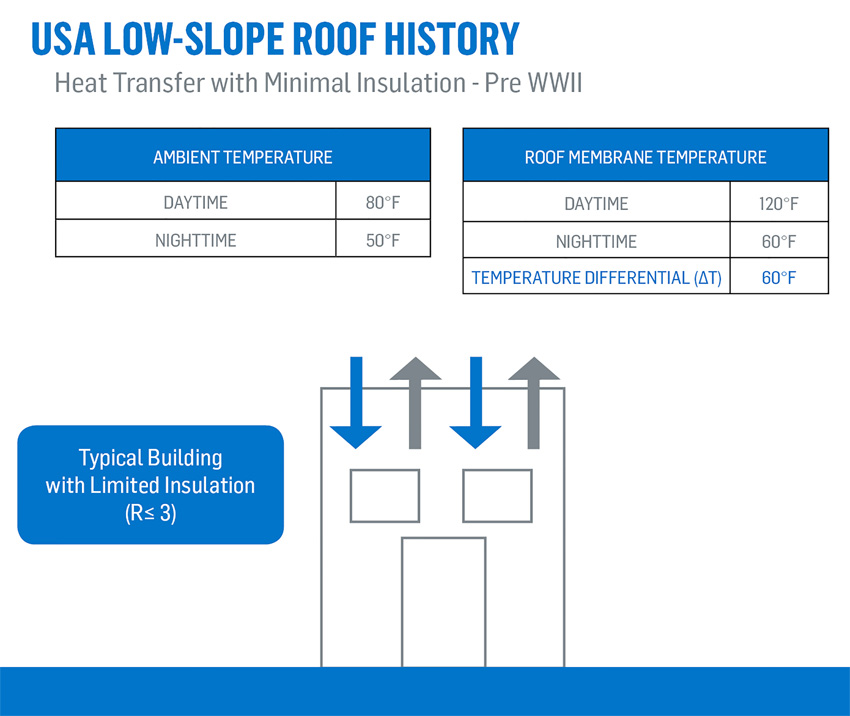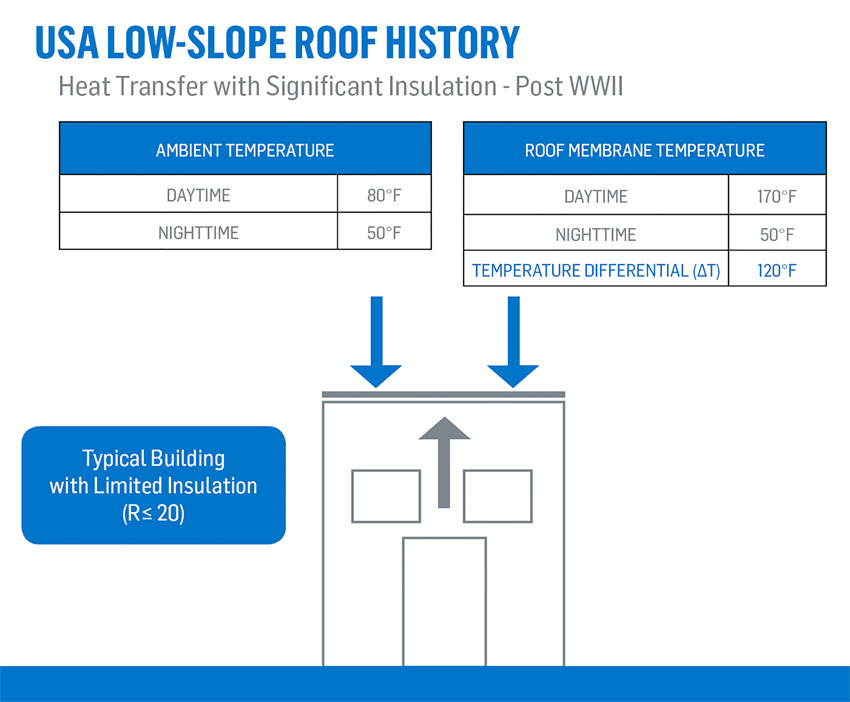SBS-Modified Bitumen Roofing
Historical Overview
Bitumen has been used for centuries in its natural form to waterproof everything from boats to bathtubs to buildings. After the distillation of crude oil began, oxidized asphalt entered the market in the 1890s and became a substitute for the highly odiferous coal tar pitch that was used for built-up roofing (BUR) applications.
Felts made up of rag, paper or asbestos were saturated with asphalt and used in early BUR systems. For various reasons, including performance and availability of some raw materials, BUR felts evolved to a higher performing fiberglass composition in the 1970s. A typical BUR roof consists of 3-5 plies of these felts and some form of UV protection—usually gravel or a coating.
One thing to remember about BUR roofing membranes is that they are constructed “in-situ,” i.e., the membrane is “manufactured” by the installer on the rooftop. Individual BUR ply sheets are not watertight, but when applied with hot asphalt in multiple layers they serve to reinforce the waterproofing agent—the bitumen (asphalt). Besides its composition, the quality of the installed waterproofing agent is dependent on many factors including the skill and workmanship of the installer, the kettle temperature, the length of time in the kettle and conditions during application.
In the early 1900s, about 90 percent of the U.S. low-slope roofing market was of the BUR variety. As of 2015, only 9 percent of the market was BUR. So, you may be wondering, what happened?
To understand, all we need to do is look at pre-World War II and post-World War II market conditions.
Pre-WWII, the roof slopes were steeper than today, many times 1-3 inches-per-foot, and the rooftops were not encumbered with mechanical equipment. Air conditioning was not common, there were no satellite dishes or cell towers, and there were few roof vents. Rooftops were generally simpler. Roof decks were made of wood or concrete, meaning there was very little movement in the roof deck and the structure. Asphalt and felts and quality bitumen were prevalent. Finally, there was a large labor force that was accustomed to manual labor and in need of well-paying jobs.
After WWII, a lot changed. Buildings’ roofs were often built with slopes of less than 1-inch-per-foot. Lightweight steel decks were used, which made for more expansion and contraction and therefore more deck movement, but less mass than wood or concrete to absorb heat as a heat sink. There was also an increase in the use of rooftop insulation in the mid- 1900s, meaning that more of that heat energy would not be transferred, and would rather attack the roof surface. In addition, HVAC and other equipment moved to the rooftop, as did traffic, tools, and chemicals to install and maintain that equipment.
The Effects of Insulation on Roofing Materials
You have probably heard the term “R-value” used in conjunction with insulation before. Basically, this value tells us how well the insulation material will resist transferring heat through the board. The reporting of this value has changed somewhat over the years to show an average over 15 years, to give a better idea of the long-term thermal resistance of the insulation material, i.e., LTTR.
What does this have to do with roofing? As you begin to increase the use of low-density, high R-value insulation on a roof, there is more heat being absorbed by the roofing membrane instead of being transmitted elsewhere. In this case, we are accelerating the temperature and subsequent negative aging effects on the roof membrane.

When there is minimal insulation installed near the roofing surface, heat transfers more smoothly to the structure, reducing the heat load on the roofing membrane.
In the image depicting pre-WWII construction, you’ll see that a roof with minimal insulation allows the roof deck and the structure to absorb some of the heat, keeping the roof membrane relatively cool. This example depicts a temperature differential of 60F (15C).

The addition of more insulation near the roof means that heat cannot transmit as well to the structure, and therefore the temperature differential experienced by the roofing membrane is much higher.
In this above image depicting a more modern roof assembly, you’ll see a roof that is more significantly insulated. Even with the same ambient temperatures, when you add high R-value insulation, the roof membrane is now absorbing all of the heat that is being “blocked” by the insulation, resulting in much higher daytime temperatures. This example depicts a temperature differential of 120F (49C).
With this drastically increased heat load, we began to see roofs with shorter and shorter life expectancies. The Arrhenius Equation, a chemical reaction rate calculation, states that for each 18F (10C) increase in temperature the reaction rate doubles. This can be translated into an “aging” rate for the roof membrane. So you can imagine how much more drastically a roof ages when you change its temperature by 50-60 degrees. The more heat load you have on your roof, the quicker any roofing membrane will age.
Historical Overview (Continued)
At the same time that insulation installation use was on the rise, we saw a drop in the quality and availability of BUR asphalt products. Felts were no longer being made with rag, and the oil embargo of 1973 made it more difficult to obtain good quality asphalt. Ultimately, as the mechanical and heat stresses increased on the rooftop, traditional BUR was unable or unavailable to withstand them, and the market shifted to different roofing materials.
As concerns increased regarding the quality of roofing asphalt and the life expectancy of roof membranes, SBS-modified bitumen roofing was developed in France in the late 1960s. As this and other modified bitumen technology developed in Europe, the North American roofing industry began to look for replacements for BUR due to the demand for higher performing materials and less labor intensive applications.
The market wanted a more quality-controlled, watertight product that could be manufactured in a factory as opposed to the in-situ construction of BUR. SBS-modified bitumen membranes were a great option in this changing industry, and by the early 1980s, it was being applied in North America. Prefabricated and waterproof, with high-elongation and recovery properties, SBS-modified bitumen membranes could better withstand the increased stresses being applied to roofs.
And, because of their multiple-ply configurations, the typical SBS system was over 200 mils thick. Much like the felts used to reinforce the bitumen in BUR membranes, SBS-modified bitumen membranes use different reinforcement materials for practical purposes like improved installation handling and to provide mechanical properties like fastener retention, puncture and tear-resistance.









